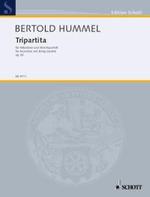Tripartita for Accordion and String Quartet, op. 85a (1986)

I. Invocation
II.
Lamentation ![]() beginning
beginning
III. Conclusion
First
performance : March 23, 1986, Trossingen, Dr. Ernst-Hohner-Konzerthaus
Hugo
Noth / Joachim Quartet (Volker Worlitzsch / Friedemann Kober / Monika Hüls
/ Stephan Haack)
Duration: 21 minutes
Publisher: Schott Music ED 9711 / ISMN M-001-13631-0| I. | II. | III. |
Video: Hummel on youtube
Suggested
by Hugo Noth, the work was written in the months September, 1985 to January, 1986.
I. Invocation:
Starting from a gesture based on four notes, string quartet sounds in eight parts
are created. Various forms of call alternate with constantly recurring sound pictures
and short melodic passages.
An extended cadenza for accordion, which seeks
to bring the diverse musical materials into relation with each other, is set against
chord blocks in the strings. With penetrating repeats, the movement ends in a
triple forte.
II.
The Lamentation stands in strong dynamic contrast to the preceding movement.
The glissando capability of the accordion is linked to glissando techniques in
the strings. The attention is centred on the increasingly powerful large-scale
structures over an ostinato bass line in the accordion. After the climax (at the
sectio aurea), the dynamics fall away rapidly; the atmosphere of the opening is
felt again briefly and fades after a few bars.
III.
Conclusion:
After a short introduction in restrained tempo, a virtuoso
vivace dominates the events in this movement, which, repeatedly interrupted and
formally subdivided by tango rhythms, short chorale-like ideas and cautious melodic
sections, is finally led to a striking conclusion.
I would be very happy
if I succeeded with op. 85 in making a constructive contribution on the theme
of chamber music with accordion.
Bertold
Hummel
Press
Trossinger Nachrichten, March, 1986
Then the
"lollipop" amongst the eleven first fruits was served. In the "Tripartita"
for String Quartet and Accordion, Bertold Hummel extracts from the four notes
b flat, a flat, d and e eight part sounds for the strings in superimposed layers
of sixths. Alongside this, the accordion constructs melodies from the same material.
With refinement, Hummel brings the two worlds of sound into constantly new relationships.
The piece ends strikingly after a final movement in virtuoso motion in scales
and tremolos. "Tripartita" will certainly soon have a sure place in
the repertoire for this combination of instruments.
Die
Neckarquelle, 25th March, 1986
The
times are past in which sonority was interesting so to speak only in its aggregate
form; it has now become an important means of expression again, not an effect
for its own sake in the cheap way practised by speculators calling themselves
composers. Bertold Hummel's "Tripartita" for Accordion and Strings,
premièred by the "Joachim-Quartett" and Hugo Noth, exploits sonority
in this new sense. In the second movement ("Lamentation"), glissandos
are the magical means used to graft together these fundamentally different types
of instrument. The work commences dramatically, intensifying the dialogue to a
previously undreamed-of density and concentration. As in a kaleidoscope, expressive
gestures and figurative ideas of compact dimensions clash with each other until
near the end, as a fulminating last dance.
Hummel certainly links his ideas
to traditional formal structures; the musical language has an original effect,
we are tempted to say "polyglot". The "Tripartita",
received enthusiastically by the audience, proved to be one of the few valid works
of chamber music for accordion which could be presented at this year's "Trossinger
Musiktagen".
NMZ,
1986
Bertold Hummel's
"Tripartita" captivated with its coherently interconnected "call"
ideas, a middle movement based on glissando passages and a final virtuoso movement
with different rhythmic and melodic elements. Hummel has written music to get
hold of, immediately followable and comprehensible.
Anne Borkowki
